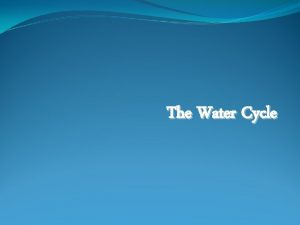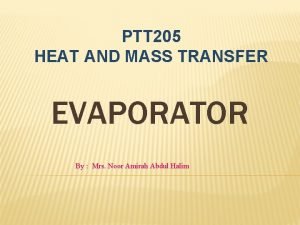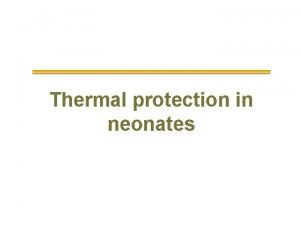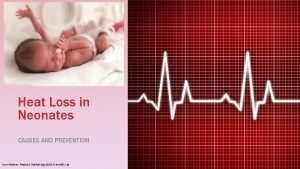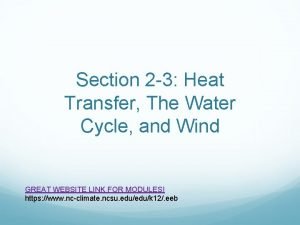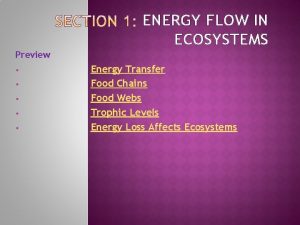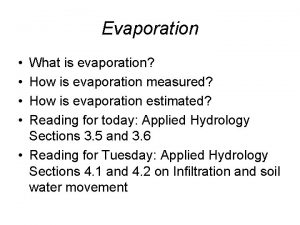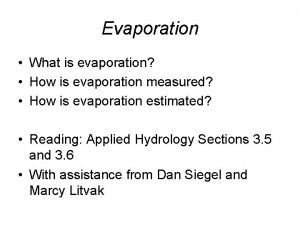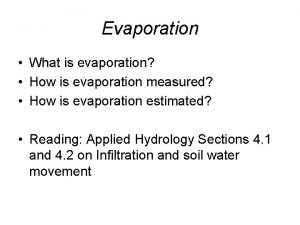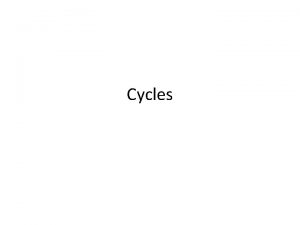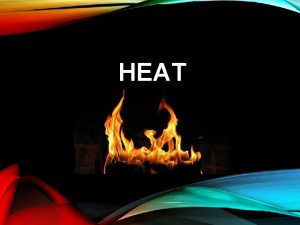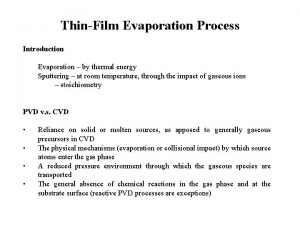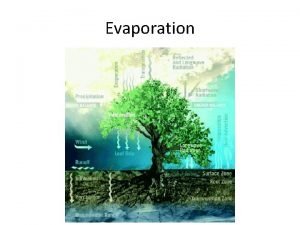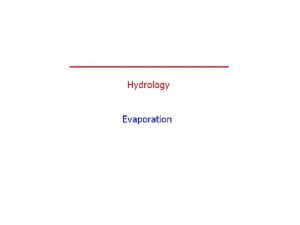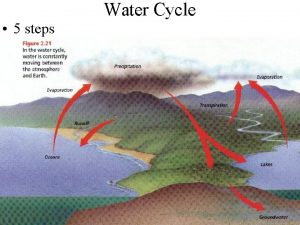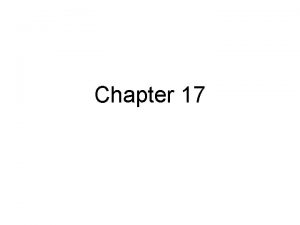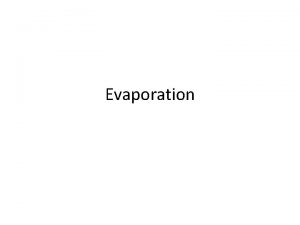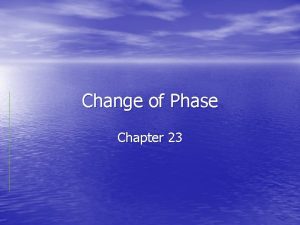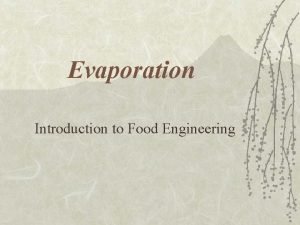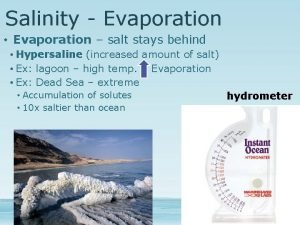Water water cycle Evaporation Heat energy from the































- Slides: 31

Water

water cycle



Evaporation • Heat energy from the sun causes water in puddles, streams, rivers, seas or lakes to change from a liquid to a water vapor. • This is called evaporation. • The vapor rises into the air and collects in clouds.

Condensation • Water vapor collects in clouds. As the clouds cool the water vapor condenses into water drops. • This is called condensation. • These drops fall to the earth as rain, snow or hail.

Precipitation • Water falls to the earth from clouds. Mainly as rain, but sometimes as snow and hail. • This is called precipitation.

Transpiration • Transpiration is the process by which plants lose water out of their leaves. • Transpiration gives evaporation a bit of a hand in getting the water vapor back up into the air.

Condensation The movement through plants The Clouds form Transpiration Precipitation The rain falls Evaporation The vapor rises

The Water Cycle Movie • http: //www. brainpop. com/science/ecology/ watercycle/index. asp • Watch the movie • Take a Quiz

WATERSHEDS Connecting Weather to the Environment Produced by the COMET® Program in partnership with the National Environmental Education Foundation

What is a watershed? A watershed is an area of land from which all runoff drains, or 'sheds' to the same river, lake, or other body of water. Runoff-Water travels downhill and enters into rivers and lakes.

Everyone lives in a watershed You don’t need to visit the Grand Canyon to see a watershed. You’re already in one! Your own backyard is part of a watershed.

The System of Watersheds are like pieces of a puzzle: Each is part of a larger picture or mosaic.

A Nested System Larger watersheds contain smaller watersheds, which contain even smaller ones.

Watershed Addresses Just as our homes have street addresses, our neighborhood watersheds have environmental addresses.

Where does our water come from? All of our freshwater starts as precipitation, which moves continually through the hydrologic cycle. Condensation Precipitation Snowmelt Evaporation Streams and Lakes rivers Springs Aquifers Ocean Storage Groundwater flow to oceans Infiltration into the ground

The Surface-Groundwater System • Ground Water- flows underground as springs or underground rivers. Water underground is stored in an aquifer. • Surface and underground water bodies form an interconnected system. Surface water recharges groundwater storage. • Groundwater also flows up into surface water bodies.

Aquifers • Aquifer: a body of saturated rock or sediment through which water can move easily

Ground Water • Brain Pop Video • Ground Water Quiz

What is a Water Table? • Water Table-The water table is the underground depth at which point the ground is totally saturated with water. • Much of the Earth's water is actually locked up underground, and while it may not be as physically obvious as big lakes and rivers, it is critically important. • When underground water deposits are large enough to be considered sustainable for use, they are known as aquifers. The water table could also be thought of as the top of the aquifer.

Water Table

Drinking Water Sources Most water systems (80%) in the U. S. use a ground water source for drinking water, but the majority of the population (66%) are served by surface water sources.

Weather & Watersheds: Pollution What is the most common cause of pollution in streams, rivers, and oceans? • http: //www. youtube. com/watch? v=a-x 0 AJQ 5 z. HQ&feature=fvwrel 1. Dumping of garbage by cities 2. Surface water running off yards, streets, paved lots, and farm fields 3. Trash washed into the ocean from beaches 4. Waste dumped by factories

Sources of Pollution Precipitation runoff from farms, lawns, and paved surfaces is the leading source of water pollution in America today.

What’s in the water? Main pollutants: • Fertilizers • Herbicides • Insecticides • Oil, grease, and toxic chemicals from urban areas • Sediment • Road Salt • Bacteria and Nitrogen • Air pollutants

Protecting Watersheds: What You Can Do Everyday Simple Ways to Protect Your Watershed • Don’t Dump or Litter • Water and Landscape Wisely • Control the Flow • Pick up After Rover • Fix that Leak • Participate in a Cleanup • http: //www. youtube. com/watch? v=Ku 5 dg. Ut. Xc. Lo&featur e=related

Terracing • Terracing-Terracing is a soil conservation practice applied to prevent rainfall runoff on sloping land from accumulating and causing serious erosion. It also helps collect run-off.

What is a Basin? • Basin is an extent or an area of land where surface water from rain and melting snow or ice gathers to a single point, usually the exit of the basin, where the waters join another water body, such as a river, lake, or ocean.

What is a Spring? • A spring is a point where water flows out of the ground. A spring may flow the whole year or only sometimes. This depends on the water getting into the ground all of the time (rain) or only once in a while (snow melting).

What is a Cone of Depression? • A cone of depression occurs in an aquifer when groundwater is pumped from a well. • A cone results from changing groundwater flow direction. As the well pulls water up from underground, soils falls inward, which creates a cone shape.
 Evaporation water cycle
Evaporation water cycle Horizontal
Horizontal Neutral thermal environment chart
Neutral thermal environment chart Conduction heat loss newborn
Conduction heat loss newborn Water and water and water water
Water and water and water water Water
Water Transpiration is the evaporation of water from
Transpiration is the evaporation of water from Thermal energy vs heat energy
Thermal energy vs heat energy Condensation process example
Condensation process example Water exchanger
Water exchanger Water cycle brainpop
Water cycle brainpop Water cycle the hydrologic cycle
Water cycle the hydrologic cycle Energy energy transfer and general energy analysis
Energy energy transfer and general energy analysis Energy energy transfer and general energy analysis
Energy energy transfer and general energy analysis How is energy transferred within the water cycle
How is energy transferred within the water cycle Specific heat capacity of lead j/kg c
Specific heat capacity of lead j/kg c Specific latent heat
Specific latent heat Dry heat method examples
Dry heat method examples Hình ảnh bộ gõ cơ thể búng tay
Hình ảnh bộ gõ cơ thể búng tay Ng-html
Ng-html Bổ thể
Bổ thể Tỉ lệ cơ thể trẻ em
Tỉ lệ cơ thể trẻ em Chó sói
Chó sói Tư thế worm breton là gì
Tư thế worm breton là gì Chúa yêu trần thế alleluia
Chúa yêu trần thế alleluia Môn thể thao bắt đầu bằng chữ đua
Môn thể thao bắt đầu bằng chữ đua Thế nào là hệ số cao nhất
Thế nào là hệ số cao nhất Các châu lục và đại dương trên thế giới
Các châu lục và đại dương trên thế giới Công thức tính thế năng
Công thức tính thế năng Trời xanh đây là của chúng ta thể thơ
Trời xanh đây là của chúng ta thể thơ Mật thư anh em như thể tay chân
Mật thư anh em như thể tay chân 101012 bằng
101012 bằng
